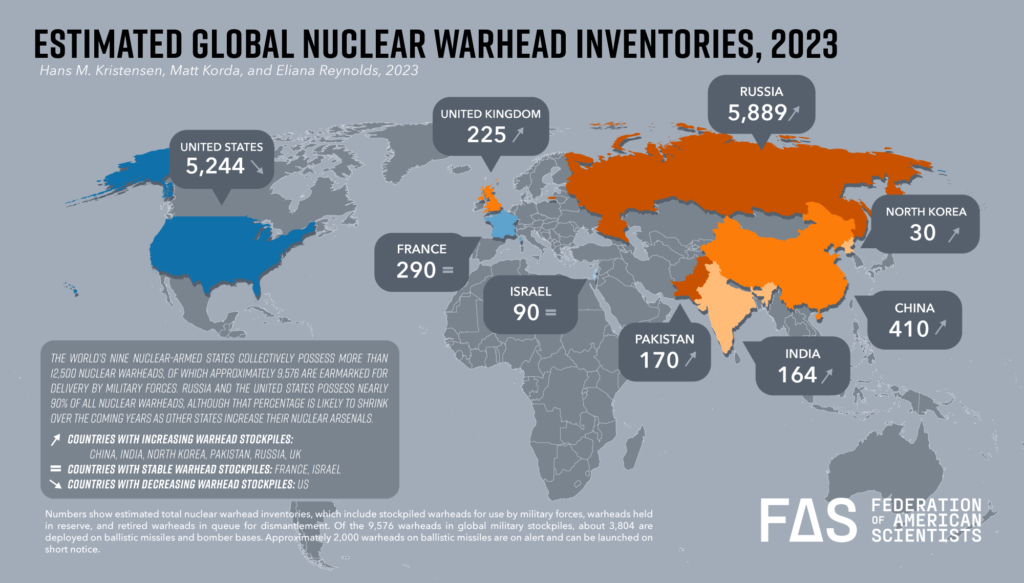
Status of World Nuclear Forces
Who owns the world’s nuclear weapons?
Despite progress in reducing nuclear weapon arsenals since the Cold War, the world’s combined inventory of nuclear warheads remains at a very high level: nine countries possessed roughly 12,500 warheads as of early-2023.
Combined, the United States and Russia now possess approximately 89 percent of the world’s total inventory of nuclear weapons, and 86 percent of the stockpiled warheads available for use by the military. Currently, no other nuclear-armed state sees a need for more than a few hundred nuclear weapons for national security, although many of these states are increasing their nuclear stockpiles.
Globally, the overall inventory of nuclear weapons is declining, but the pace of reductions is slowing compared with the past 30 years. Moreover, these reductions are happening only because the United States and Russia are still dismantling previously retired warheads.
In contrast to the overall inventory of nuclear weapons, the number of warheads in global military stockpiles – which comprises warheads assigned to operational forces – is increasing once again.The United States is still reducing its nuclear stockpile slowly. France and Israel have relatively stable inventories. But China, India, North Korea, Pakistan and the United Kingdom, as well as possibly Russia, are all thought to be increasing their stockpiles (see map):

Of the world’s approximate 12,500 nuclear warheads, roughly 9,576 are in the military stockpiles for use by missiles, aircraft, ships and submarines. The remaining warheads have been retired but are still relatively intact and are awaiting dismantlement). Of the 9,576 warheads in the military stockpiles, some 3,804 are deployed with operational forces (on missiles or bomber bases). Of those, approximately 2,000 US, Russian, British and French warheads are onhigh alert, ready for use on short notice (see table):
The exact number of nuclear weapons in each country’s possession is a closely held national secret, so the estimates presented here come with significant uncertainty. Most nuclear-armed states provide essentially no information about the sizes of their nuclear stockpiles. Yet the degree of secrecy varies considerably from country to country. Between 2010 and 2018, the United States disclosed its total stockpile size, but in 2019 the Trump administrationstopped that practice. In 2020, the Biden administration恢复核透明度– a brief victory for nuclear accountability in a democratic country – but then declined to declassify any US stockpile data for 2021 or 2022. Similarly, in 2021 the United Kingdomannouncedthat it would no longer disclose public figures for its operational stockpile, deployed warhead or deployed missile numbers. Additionally, as of 2023 both the United States and Russia have elected to no longer exchange publicly-available data about their deployed strategic warheads and launchers as mandated by the New START Treaty.
尽管存在这些限制,但是,公开可用的信息,对历史记录的仔细分析以及偶尔的泄漏使得有可能对国家核武器库存的规模和组成进行最佳估计。有关不同核武器国家的核弹头类别的细分,以及有关每个国家武器库的更多细节概述的链接,请参阅此表:
在历史背景下,自冷战以来,世界上核武器的数量已大幅下降:从1986年的大约70,300峰到估计的12,500山峰,在2023年初。政府官员经常表征由于当前或最近的军备控制协议而导致的这一成就,但实际上,减少的压倒性部分发生在1990年代。有些还将当今的数字与1950年代的数字进行了比较,但这就像比较苹果和橙子一样。当今的部队更有能力。
The pace of reduction has slowed significantly compared with the 1990s and appears to continue only because of dismantlement of retired weapons; the trend is that the military stockpiles (useable nuclear weapons) are increasing again.
核武国家没有计划核武器,而是计划保留大型武器库,以实现无限期的未来。因此,他们与条约对不扩散核武器的客观和精神相抵触。
All continue to modernize their remaining nuclear forces at a significant pace, several are adding new types and/or increasing the role they serve in national strategy and public statements, and all appear committed to retaining nuclear weapons for the indefinite future.
For an overview of global modernization programs, see our contributions to theSIPRI Yearbookand the核武器Ban Monitor. Individual country profiles are available from theFAS核笔记本.
每个国家可用的信息差异很大,从最透明的核武器国家(美国)到最不透明的(以色列)。因此,尽管美国的库存估算是基于“实际”数字,但其他几个核武器国家的估计值高度不确定。
这些核武器估计是由美国科学家联合会的汉斯·克里斯汀森,马特·科尔达和埃里亚娜·雷诺兹制作的。他们的工作是基于分析师托马斯·科克伦(Thomas Cochran),罗伯特·诺里斯(Robert Norris)和威利安·阿金(Willian Arkin)的开创性成就,没有这些公共服务。
这项工作是通过纽约卡内基公司,生命研究所的未来,约翰·D(John D.莫特基金会,植物基金会和个别捐助者。所作的陈述和表达的观点仅仅是作者的责任。